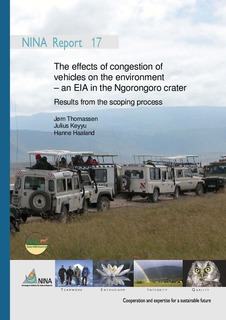The effects of congestion of vehicles on the environment – an EIA in the Ngorongoro crater. Results from the scoping process
Research report

Åpne
Permanent lenke
http://hdl.handle.net/11250/2431758Utgivelsesdato
2005Metadata
Vis full innførselSamlinger
- NINA Rapport/NINA Report [2341]
- Publikasjoner fra CRIStin - NINA [2364]
Sammendrag
Thomassen, J., Keyyu, J., and Haaland, H. 2005. The effects of congestion of vehicles on the environment - an EIA in the Ngrongoro crates: results from the scoping process. - NINA Rapport 17. 68 s. The Ngorongoro Conservation Area Authority (NCAA) faces a great challenge in managing the vehicle congestion in the Ngorongoro crater. They are in need for an assessment of the present situation and realistic plans for mitigating measures and other management actions. The situation is also dealt with in the revised General Management Plan (GMP) for the Ngorongoro Conservation Area (NCA), which soon will be finished. Tanzania Wildlife Research Institute (TAWIRI) and Norwegian Institute for Nature Research (NINA) collaborate on capacity building, of which Environmental Impact Assessment is one of the tasks. In the capacity building programme it has been decided to use a concrete EIA as a training tool, where different training packages (proposal writing, project managing, reporting etc) are included. NCAA, TAWIRI and NINA have decided to use the vehicle congestion in the Ngorongoro Crater as the EIA case in the capacity building programme. This report documents the scoping process, conducted in a five days workshop in Karatu 11. – 15. October 2004, supplied with further scoping at meetings in Trondheim later on. A major challenge in EIA is to identify the limited number of issues to be addressed by the EIA (Beanlands 1988). This process is called scoping and will normally include considerations of impact factors and potential impacts, decision makers, stakeholders, alternatives, access of baseline information, time schedule and also economic frames. The scoping phase in EIA is critical for an optimal use of limited resources in the perspective of personnel, time and economy, and should be accomplished as early as possible in the process. The participants at the Karatu workshop consisted of various stakeholders: Ngorongoro pastoralist council, COSTECH, Mweka college, NCAA, NEMC, TANAPA, TAWIRI, WD and NINA. Unfortunately, the tourist industry was not able to attend the workshop. Several lectures were given to clarify the situation in the NCA and the workshop process (see appendix). The Adaptive Environmental Assessment and Management (AEAM) was used as a working approach to the scoping. Out of 13 impact factors assessed, 6 were given priority. 24 Valued Ecosystem Components (VECs) were assessed, 9 were given priority. For each of the VECs a schematic flow chart was constructed and a number of impact hypotheses were formulated and evaluated for each of the VECs. Due to limited resources for conducting the EIA study, further scoping was necessary subsequent to the Karatu workshop. An expert group consisting of representatives from MNRT, TAWIRI and NINA did an additional scoping in Trondheim, Norway 03.11.04. The number of VECs were reduced and/or combined from 9 to 2 VECs, namely: A. Human aspects (analysis of tourism issues and the Maasai community, related to EIA); and B. Ecological aspects (analysis of vehicle impacts on endangered species, carnivores and sensitive habitats). For each issue objectives, outputs, activities and budget, time frame and staffing were proposed.